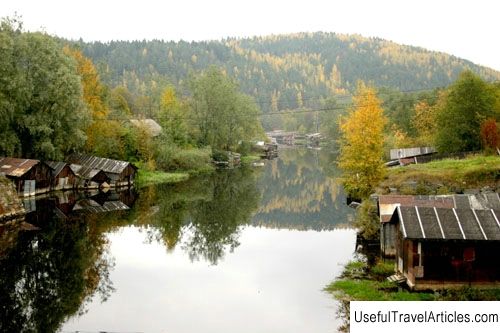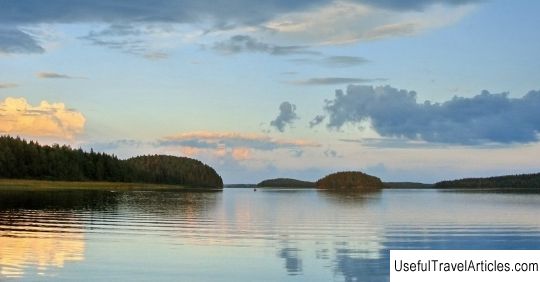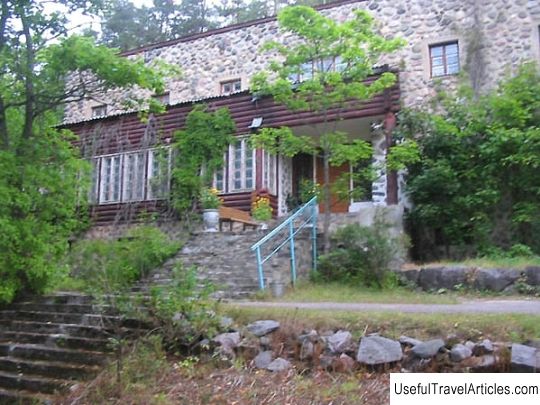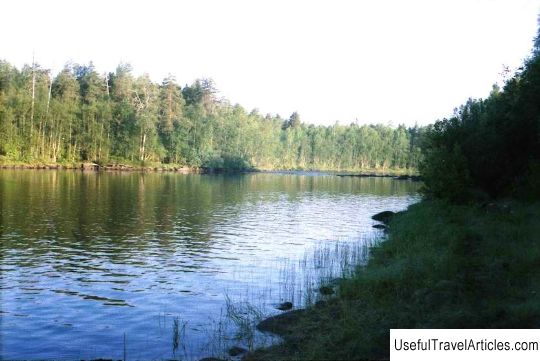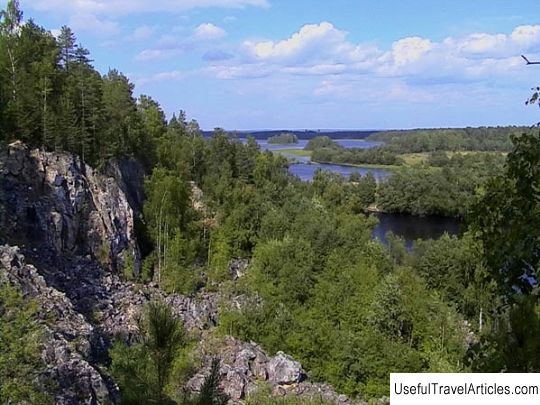Mountain Park ”Ruskeala” description and photo - Russia - Karelia: Sortavalsky district
Rating: 7,9/10 (689 votes) 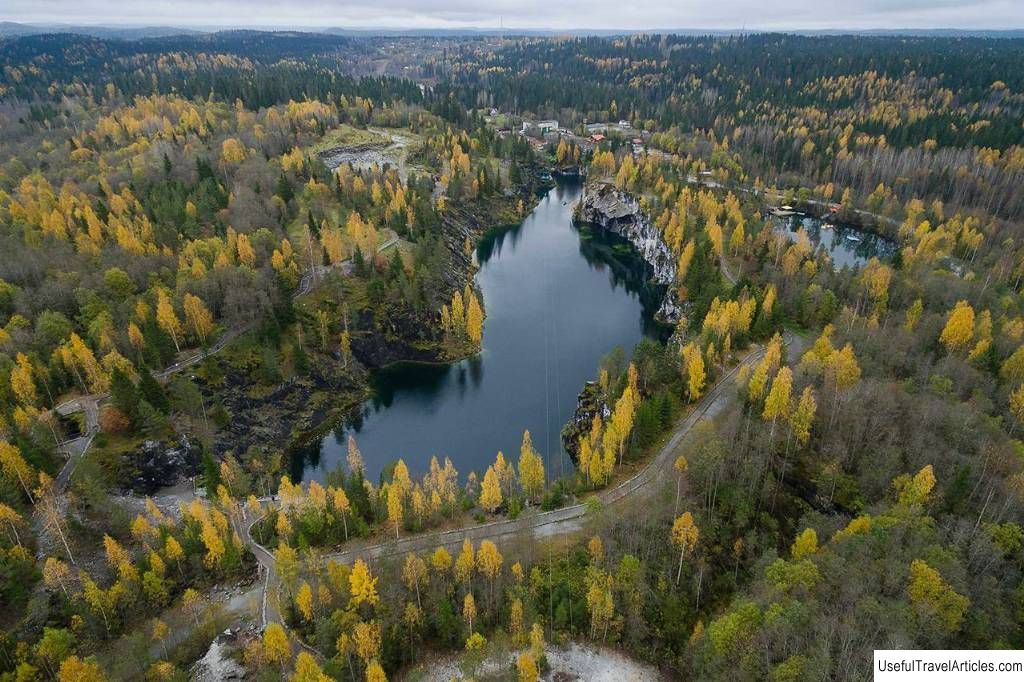
Mountain Park "Ruskeala" description and photos - Russia - Karelia: Sortavalsky district. Detailed information about the attraction. Description, photos and a map showing the nearest significant objects. Photo and descriptionThe most beautiful marble in Russia is mined in Karelia, in the vicinity of Sortavala. On the site of the largest Ladoga deposit, which supplied the most beautiful and pompous palaces and temples of the Russian Empire with marble, there is now a picturesque natural park. This is an amazingly beautiful lake with clear water in silvery rocks, formed on the site of a marble canyon. Here you can see underground adits, take a boat ride on the lake, jump from a bungee and much more. History of the canyonThe name is derived from the name of the river - Ruskolka. It means "red" - its water was reddish with iron, and ocher has long been mined along its banks. They began to look for a building stone near St. Petersburg under Catherine II, because then a huge construction was underway. In 1766, marble mining began here, primarily for the construction of the new St. Isaac's Cathedral in St. Petersburg, designed by Antonio Rinaldi. The development was carried out on Mount White, entirely composed of silver marble, and Mount Green, where the marble was of a different color - with green veins. The mining was carried out by the simplest method: holes were drilled in the rock, filled with explosives, and thus chunks were chipped off, which were then processed and polished. Local marble was used in the 18th-19th centuries to decorate the pavilions in Tsarskoye Selo, the Mikhailovsky Castle of Paul I, and the Kazan Cathedral in St. Petersburg. Since 1819, construction began on the fourth building of St. Isaac's Cathedral - just the one that has survived to our time. It is again faced with Ruskeala marble. The chief architect of the cathedral - Montferrand - personally comes here to observe the work of the quarry; in total, up to 700 people work here at a time. It also organizes a plant for the production of lime. Since 1854, industrial lime has become a priority. The field has been actively developed until 1939. New adits, mines and quarries are breaking through. Rock is mined at six horizons - three underground and three aboveground. Lime, marble chips and crushed stone are produced here. The main quarry is 450 meters long, 150 meters wide, and is surrounded by a system of adits and mines. Many official buildings in Helsinki, such as the National Bank and the Ministry of Defense, are decorated with this marble. But after the war, when the territory again returned to Russia, it was in the main quarry that work was no longer carried out: its depth reached the level of groundwater, and it began to flood. The lime plant was rebuilt, and the main quarry was gradually filled with water from underground springs and formed a picturesque lake. The quarrying of marble continued in other quarries using Western European technologies. In Leningrad, the marble quarried here was used to decorate the Ladozhskaya and Primorskaya metro stations. Only at the very end of the 20th century, mining was stopped. The park is now The park traces its history back to 1999. A year before that, the territory was officially declared unsuitable for mining, and in 1999 the concept of the park arose, and excursions began. Since 2001, clearing of the territory began, and in 2005 the first ecological path was laid, and a boat station was opened on the lake. In 2017, a 650-meter underground route was launched. Speleologists conduct their research here - and perhaps in the future, tourists will find several more open and equipped caves and longer underground routes. Since 2009, the marble slopes have been equipped with lighting, so that in the evening the park is especially beautiful. From Sortavala to the park now you can get on a real steam locomotive that copies the famous "Nikolaev Express". The dungeons can only be entered as part of an organized group with a guide - it can be dangerous here alone. The route is laid along the old adit, created in 1930 by the Finns - marble from the mines below was transported along it. Lakes What people come here for is a lake, almost half a kilometer long, formed on the site of a marble canyon. Its depth is almost 50 meters, and its high banks are formed of open marble deposits of silver-gray and white color. An unforgettable sight. The lake is fed by mountain streams and its water is absolutely transparent. Here and there at the bottom of the lake you can see mining equipment abandoned here - it is at a depth of 18-20 meters, but you can see it. Several ecological trails with observation platforms in the most picturesque places are laid around the lake. There is a boat station on the east bank. To the west is another lake - Lake Montferrand. It is named after the architect who designed the famous St. Isaac's Cathedral, which was decorated with local marble. It is smaller and of a different shape, not elongated, but round, but no less picturesque. Ruskeala Gap and Kalevala Park Another must-see object is the Ruskeala hole. In the middle of the 20th century, after the explosion, the vaults of the underground excavation collapsed, and a thirty-meter failure was formed. The ice never melts here, but in summer a small underground lake is formed, so inspection of the hole turns into an extreme attraction. It is necessary to descend the rope into the boat, and on it already inspect the failure. In winter, you can go down directly to the ice, which freezes in the depths of the hole. The "Italian quarry" is surprisingly beautiful. Here, marble was mined in the middle of the 20th century using Italian technology - "removing" it from the rock with flat plates. As a result, half-cut rocks were formed, on smooth sections of which the structure of the marble rock is perfectly visible. There is a small square lake, which is so beautiful that it received the local name "Cleopatra's pool." Children will have an interesting part of the park dedicated to the Finnish epic Kalevala. Kalevala was once recorded in these places - in Finnish villages around Sortavala. It, as befits in mythology, is divided into two parts. Light - Vainola and dark - Pohjala. The figures of the heroes of the epic are installed here, and at the entrance they distribute booklets with the presentation of Kalevala. The most interesting thing here is the observation deck over a high and dark cliff. In addition, quests and interactive classes are held for children. Entertainment The park provides many entertainment services. Guided tours of underground tunnels with an underground lake are held here. There are caves that you can only swim into from the lake - so there is the possibility of a boat trip with boat rental. There are bungees, a rope bridge over the canyon at a height of 24 meters, trolls - a rope descent to the lake with a roller. There is a rope park for children "Kubik". Divers can rent a dive platform and explore the underwater beauty of the lake. The park is well equipped for winter fun. Every year it is decorated with a gallery of ice sculptures. Husky rides from a local nursery are organized here. Not far from the park there are tourist centers and tent camps, so you can come here for more than one day. There are three cafes in the park, and in front of it there is a free guarded parking lot. In the vicinity of the park, you can ride ATVs, and rafting on the Tohmajoki River is also organized. The famous Ruskeala cascade, a picturesque system of four waterfalls, is located 4 kilometers from the park. The remains of the plant that once produced lime are formally located outside the territory, but they are very close. However, only brick 25-meter pipes remain here, but they look impressive too. Interesting facts
Note
                               We also recommend reading Palac Goldsteinow description and photos - Poland: Katowice Topic: Mountain Park ”Ruskeala” description and photo - Russia - Karelia: Sortavalsky district. |
